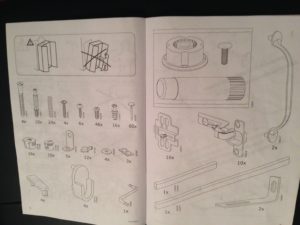Ikea exists to test me.
The Swedish masters of flat-pack furniture seem to have been designated by the universe to ask hard questions of me.
“We know you are not a home-improvement guy. Not mechanical at all. Ignorant of electrical workings. Not to be trusted with anything plumbing-oriented, aside from (perhaps) a plunger.
“But can you follow fairly simple directions and assemble a piece of furniture? Directions so basic that no words are printed in the instructions?
“The only tools needed are a screwdriver and a hex-headed version of same, and a hammer. And an Allen wrench, which is included.
“Can you manage that?”
I can almost hear the contempt in a Swedish voice.
Well, yes, I can do it! (Or so I say until the thing is in front of me.)
And I readily concede … it often is a close-run thing.
It doesn’t seem all that simple when you look at the screws and bolts and the ingenious do-hickeys that hold together what is going to be a big, ol’ armoire.
Looking at the parts list here … and I see 267 items listed, which arrived at my home in four plastic bags.
And that is just the little stuff. That does not count the made-of-particleboard walls and shelves and legs, nor the three doors which must be hung, nor the mirror that is lodged inside one of those doors.
At the start of this one, I thought perhaps I had met my match.
Our place in the south of France has more than a dozen bits of Ikea furniture, all of which I constructed.
But I had never taken on one this heavy, not with this man moving parts.
I had to fight off a bit of panic. Deep breath. Exhale. You’ve done this before. Maybe not to this scale, no.
And I was off. Staring at the parts list, then at each of the 40 (!) sets of directions. Where do you start? At the beginning.
In the real world, handy people probably would look at this and say, “That’s easy!” And for them it might be.
For me, I have to take every bit of wood and puzzle over which end is up, which is left and which is right because one mistake on that — say, having a length of decorative wood upside down — nearly always lead to a dead end. And going back and doing it all over again.
This time I backed up only twice … though I should have made it three or four. I ended up pushing in three wood screws salvaged from a previous piece of furniture, and so far …
So, three hours one night, most of it squatting on the floor of a bedroom that is about to become too small, looking at the piece of wood in my hands, glancing back to the instructions. Checking. Checking. “This side with the notch faces in here, right?”
And the armoire to be, seeming to mock me. Lying limp. Telling me to do my worst.
It was a fight to the end. The final steps were hanging the doors, which operate thanks to some particularly clever fellow who invented hinges that slide on to another piece of metal and lock in place.
How did that happen?
By the end of Day 2, and the second three-hour run at this, I didn’t care how it happened.
What I do know is that something that looks very much like the picture of the wardrobe on the front of the instructions … is standing tall and wide in front of me.
And of those 267 pieces of stuff? I had six left over, and those pertain to attaching the piece of furniture to the wall, which I chose not to do. As well as about 15 little nails I decided not to pound into the folding sheet that serves as the back of the armoire.
I did not feel triumphant as much as happy to have survived the latest test by those clever Swedes.
“Bring on your toughest piece, your least penetrable instructions, and hell if I want I can beat you!”
Well, let’s take that back. I’ve gotten through what has been put in front of me, often backtracking and once in a while not doing it quite right … but it all is standing.
So far.



0 responses so far ↓
There are no comments yet...Kick things off by filling out the form below.
Leave a Comment